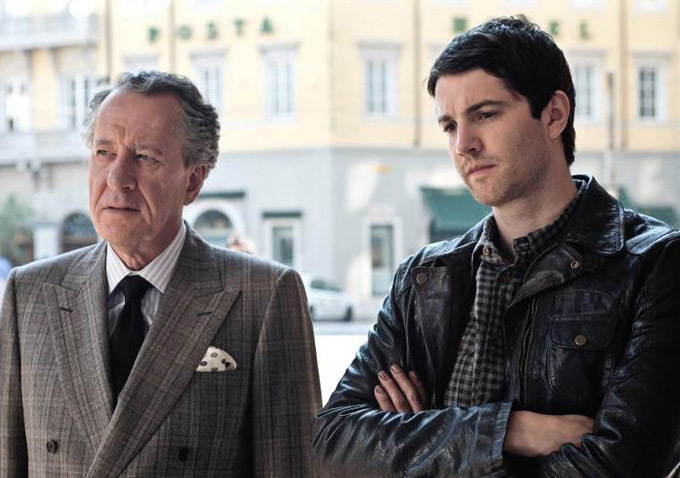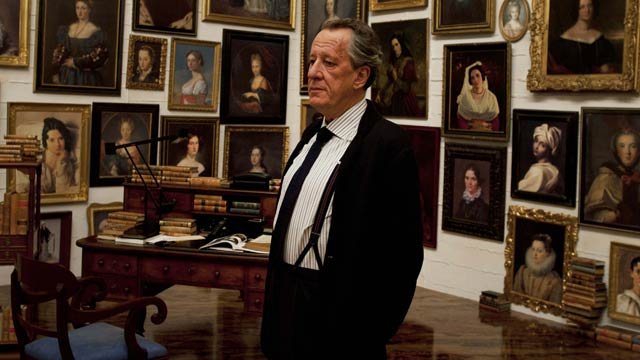|
Geoffrey
Rush's layered, dominant performance is the thematic and emotional crux
of this
very dense but mesmerising thriller. In one of his best performances,
he plays
his character Virgil Oldman with theatrical notes, making the
auctioneer an
impatient and callous man, who is suffering from rhypophobia. His
antisocial
behaviour and general disregard of other people signposts this as being
a story
about a man who learns to reconnect with people and to become a better
person.
Throughout the film Virgil does attempt to reconnect with the world by
aiding
an unseen woman named Claire (Sylvia Hoeks), who communicates with him
through
a wall as he helps her value the property of family belongings. This is
a mere
starting point as the rabbit hole of the narrative is far deeper.
There is
a distinct European temperament to the
material, courtesy of Italian filmmaker Giuseppe Tornatore (Cinema Paradiso),
whose deliberate pacing of the story
provides the narrative with time and spatiality to enhance the themes
and
characters. The central relationship between Virgil and the mysterious
Claire
has a fascinating basis, not because of what it provides Virgil, but
how it
challenges him. Who is this woman and why is she hiding? The suspense
is
Hitchcock in tone because we're intrigued by what we're not seeing off
camera
as much as Virgil's delicate actions. This mystery is trumped by story
beats
that dissolve into intense peaks of voyeurism, enhanced by a Roman
Polanski
inspired feel for claustrophobic interiors.

Virgil
is a
terrific character. As an art expert he has an eye for detail that
provides
with him the investigative senses of a detective. Watch his intensity
increase
as he talks to Claire on his mobile phone, hearing the echo of noises
around
him and through the phone. He knows that she must be nearby. Their
relationship
is rich with irony, a bond drawn from an aversion to sociality and
people
themselves. Tornatore's handsome interior stylisations reflect the
internal
psychology of his lead character. Scenes are filmed with a wide angle
lens,
positioning Virgil as a smaller figure in the middle of large open
room. This
asserts his emotional distance and failure to understand people, women
in
particular. As he grows mentally and physically closer to Claire and
the wall
that hides her, the framing is purposefully tighter to assert their
union of
agoraphobic tendencies. Additional glimpses of his home life reveal a
highly
desaturated, untouched and sterilised living quarters.
Cleverly,
the film's tension levels are spread outside the main story and into
two
subplots that enhance the complexity of the relationships and the
overall plotting.
Virgil has two associates with vastly different motives. The first is
his
friend Billy (Donald Sutherland) who schemes with him on auctions.
Virgil
conducts the auction, while Billy sneaks in a deliberate final bid. The
other
man is Robert (Jim Sturgess), who works in a workshop with mechanics
parts.
Robert forms an unexpected second mystery in the script. As Virgil asks
him for
advice on women and subsequently how he can grow closer to the Claire,
Robert's
inner life comes to the fore. He is continually surrounded by various
women
when he is meant to be in a relationship. If his advice is genuine, why
is his
personal life such a mess and what is the significance of the robot
that he is
constructing from various cranks found around Claire's family mansion?

One of
the theories Robert questions about the robot
is whether there was someone once manipulating it from the inside. The
same can
be said about Virgil because of the artificiality of his life and the
manipulation that occurs between these characters. One of the key lines
in the
film is "there is always something authentic concealed in every
forgery". Deception becomes
Tornatore's
concluding theme, along with physical and mental disorientation. The
idea is
that as Virgil loses his bearings on time and space we do too so that
we
experience indistinguishable emotions about the real and fake. On top
of this
is a midget character with a photographic memory and a fast tracked
timeline,
which makes for a confusing, mind-bending last quarter. I am still not
entirely
surely what happened but films that let you guess the ending by the
second act
are stale and boring. This will provoke discussion, not only because
it's
strange and ambiguous but because of the complexity of the writing and
the
various layers of the inspired central performance.
|